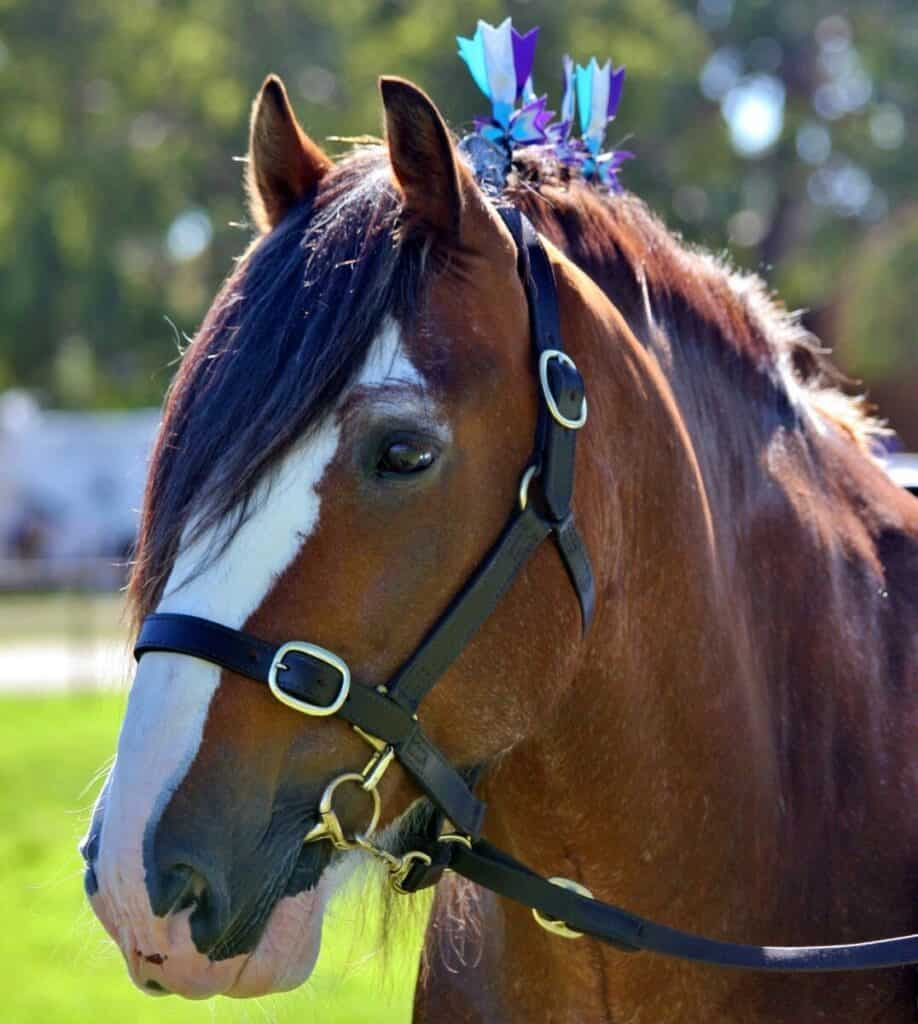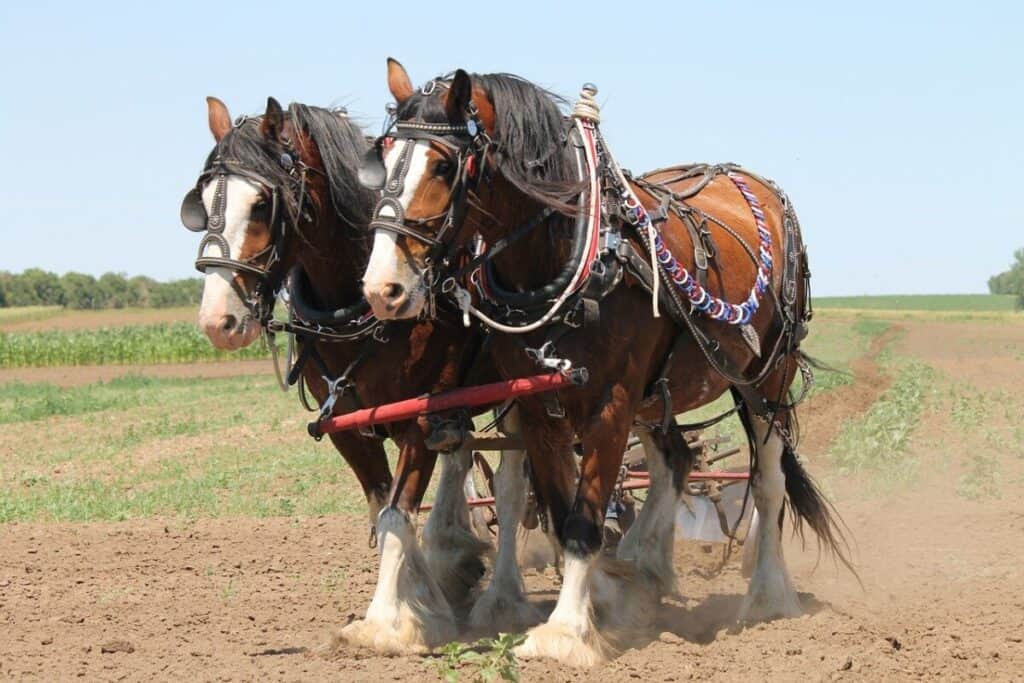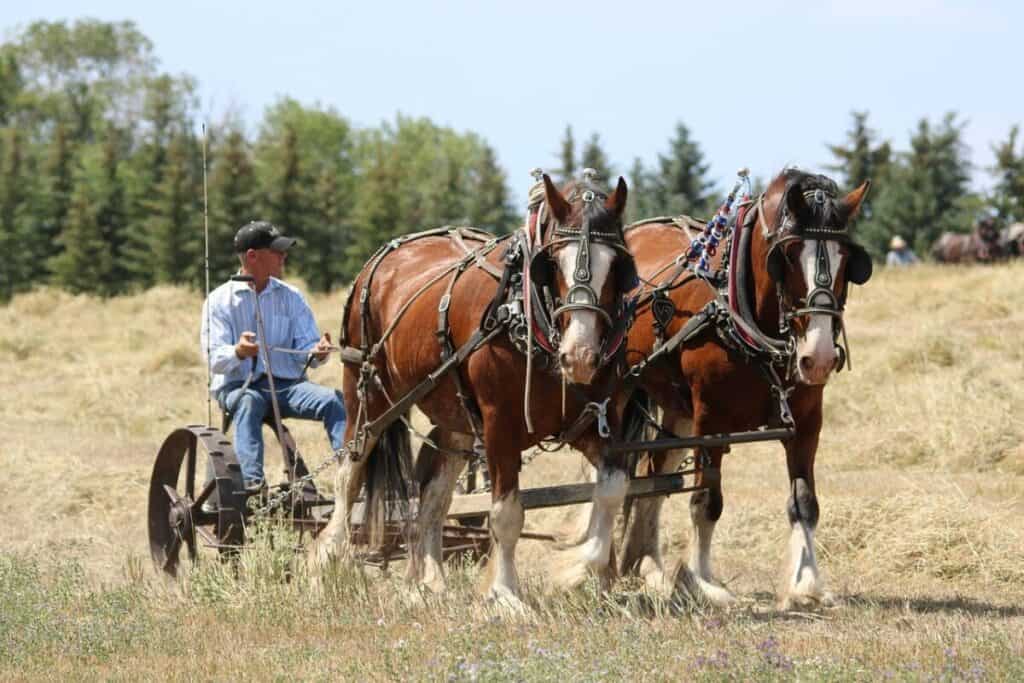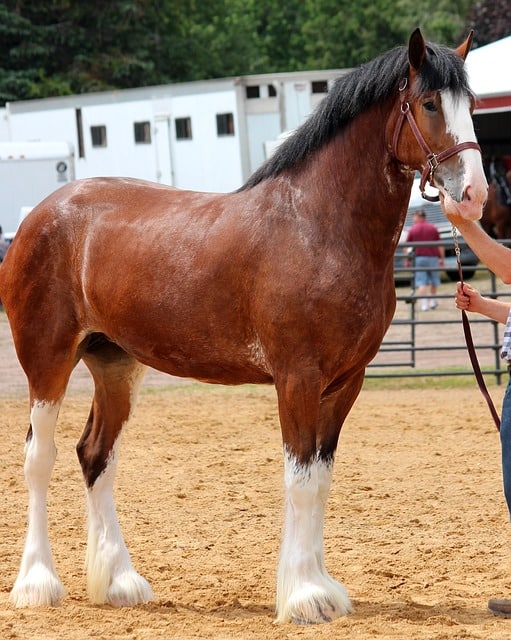When we think of the gentle giant Clydesdale, it’s pretty common to automatically imagine the ten majestically groomed and breathtakingly robust bays pulling along the brilliant red Budweiser carriage, right? These are truly creatures of power and versatility, stunning our eyes every time they take a monumental step.
Developed first to work the harsh grounds of our ancestral farmlands, to their contribution in many wars, to their continued athletic range reaching into the show pen, this breed has been around the block a few times. But have you stopped and wondered where this hulk-of-a-breed came from? Their history and ever-developing story follows a tale of national expansion with an undying commitment to the human race, all while making them one of the most well-known breeds in the world. Furthermore, those ten famous bay Clydesdales have a lot more to do with Irish tradition than you might have originally thought.

History
The modern Clydesdale made his first appearance during the late 18th to early 19th centuries, born into the now-named town of Lanarkshire District of Scotland. Shortly after his birth into this new world, it was decided to name this tiny powerhouse after the strong and ceaseless river down the way, The River Clyde. Life moved pretty fast these days, and the quest for expansion was well underway, sending the fresh breed off to Canada and down into Northern America, where the breed was promptly suited to their new occupation in the realm of agriculture. During the 1880s, the breed would commonly be seen plowing fields, carrying large crop wagons as they were the decade’s primary form of power machinery.
Back in Ireland, farmers and breeders alike were in search of making the perfect versatile horse capable of ploughing the fields during the week and entering the show pen at week’s end. The great Irish Draught had become the ideal vision of a work-play horse, but a missing piece remained, more strength. In efforts to remedy this predicament, several Irish Draught mares were then bred to Clydesdale stallions and various Warmbloods, crossing the national breed of Ireland with a breed that ceaselessly proved its versatility and strength. The product, you ask; a gentle-tempered, unparalleled worker by day and by “night” an athletically driven, fluid-moving horse.
The Clydesdale As a War Horse

The Clydesdale Served as a War Horse in World War I Fighting Alongside Soldiers in the Pursuit of Freedom
By the year 1877, the Clydesdale Horse Society was established as the breed’s first known registry. As any great story goes, with great prosperity comes the eventual tragedy, sparking a new age for the breed. During the early 1900s, the world was met with great struggle and grief as the nations of the globe fought for self-benefiting industrialism and conquest. The Great European Wars and World War I of 1914 were well underway, swallowing up anything and anyone who dared to enter their premises. Against their own free-will, the Clydesdale was hand-selected to hold the fore-front of various armies to fight alongside the soldiers in their pursuit of freedom. What once made them the popular versatile breed, now became their downfall and the reason they came face-to-face with extinction.
Following the harrowing aftermath of the wars, the breed had little left to contribute to society, but their fight with hardship had only just begun. During the 1920s, industrialism had become a primary focus in efforts to rebuild a world broken by the wars, leaving the breed of the Clydesdale unemployed. The tractor was the machine of the century, fitting a week’s worth of work into one day. The work part of the work-play horse was no longer required, and by the year 1945, the number of working Clydesdales was outnumbered by tractors. While this time proved challenging to the breed, their willing spirit and kind heart inspired a triumph over the piling obstacles.
While few Clydesdale still remained as working horses, they re-entered the world of eventing with a passion, which further energized a career in entertainment. The breed’s big break took place during the year 1933 when the famous ten-manned team was created. Given as a gift to the CEO of Budweiser Brewery by his son, the team signified the company’s way of celebrating the repeal of prohibition. In light of this occurrence, the breed got a new lease on life, representing the triumph of the nation and reinstating their popularity in a new and exciting way. Equestrians began to once again appreciate their adaptable nature and gentle temperament, as more and more Clydesdale cross-breeds entered the show arena across the globe.
Following their Service on The Farm & During the War, The Clydesdale was pushed to brink of Extinction. One of this Breeds Big Breaks was in 1933 When the Famous 10 Manned Team was created for Budweiser, as The CEO of the Company was Gifted the Team by his Son.

The Modern Clydesdale
The modern Clydesdale represents the perfect combination of hard-working ethics, steady endurance, and ready-to-go athleticism not found in any other breed. Originally used to quite literally carry the weight of the world on their backs in the name of human conquest and innovation, the breed has experienced drastic growth in occupational diversity. From endless hours of plowing fields to clearing fences with a fluid nature, this level-headed breed has certainly made a name for itself. While it is not a common practice in modern farming traditions, there are still those communities dedicated to the ways of their ancestors, choosing the horse over the machine. In the eyes of many, no tractor can ever do the great and earned work of a strong and dedicated driving horse. This dedication to the realm of agriculture is often showcased in modern conventions across the world, but more famously in the US, where four-plus horse teams are displayed pulling glamorous wagons and carriages for an entire audience of like-minded individuals. Some Clydesdales are even seen prancing through parades as drum horses. As cross-breeding practices continue on, Clydesdale-Thoroughbred-Warmblood crosses will ever remain the durable, reliable, and muscular Irish Sport Horse.Their calm-temperament matched with their durable agility makes them the perfect trail horse for any level of rider.
Teddy Bear Demeanor

Given their “teddy-bear” demeanor, the modern Clydesdale is often used as a therapy horse for riding and group therapy practices. A fun fact about these teddy bears is that each one of their hoofs weighs up to 5 pounds each, reaching the sizes of large frying pans, so you better hope your foot never comes into contact with that 5-pound frying pan. Ouch.
Considering their large size, this breed is actually a seemingly easy keeper. Due to the fact that most of the ancient Clydesdales were kept as work animals along with the cattle, they became well-adapted to eating the cow-feed leftovers including turnups, oats, and bran. They do well with a sufficient diet of pasture grass and normally do not require a detailed dietary plan. While their stomachs are strong, they are not invincible. Many Clydesdales are susceptible to chronic progressive lymphedema, which is identified by the swelling of the leg which can become of great concern without treatment. In addition, the breed commonly suffers from various skin infections, meaning that they require extensive grooming habits.
The modern Clydesdale is approximately 1600 to 2400 pounds, measuring up to 18 hands with a standard life span of 20 to 25 years. So if you are looking for a muscular horse with the ability to work and play on a daily basis, the Clydesdale is for you, just watch out for those frying pans.
This Article Was Originally Published in The April 2021 Issue of Irish Sport Horse Magazine.
